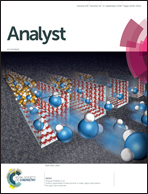A fluorescent sensor based on aggregation-induced emission: highly sensitive detection of hydrazine and its application in living cell imaging†
Abstract
Aggregation-induced emission (AIE) molecules eliminate the aggregation-caused quenching (ACQ) phenomenon effectively and exhibit excellent properties of a fluorescent sensor in the aggregated state. In this paper, an allochroic fluorescent sensor based on AIE molecules with a diphenylacrylonitrile structure was prepared in high yield by a simple procedure. This molecule possessed good AIE properties and exhibited a sensitive sensor ability for aliphatic amines with an obvious color change from orange to blue-green. The detailed investigation on the detection of hydrazine suggested that the detection limit for hydrazine was 3.67 × 10−6 M, and the highly sensitive sensor for hydrazine was not influenced by other species. The sensor mechanism was confirmed by using 1H NMR and MS spectra. The sensor for hydrazine was successfully applied in a test paper, exhibiting good practical application potential for detecting hydrazine. The experiment of living cell imaging suggested that this sensor showed superior bioimaging performance and presented sensitive detection for hydrazine with an obvious color change from orange to blue-green.

- This article is part of the themed collection: Optical Biosensor Devices


 Please wait while we load your content...
Please wait while we load your content...